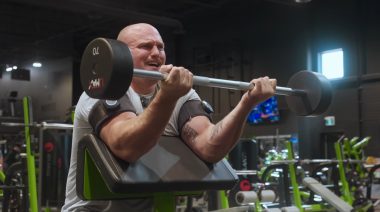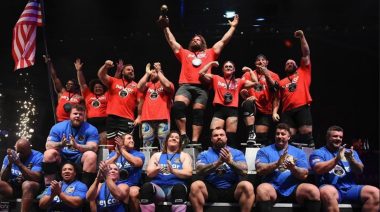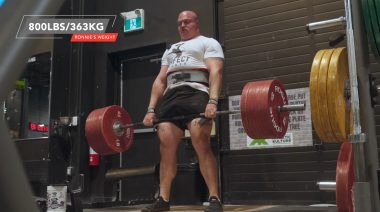Strongman events are unlike other strength sports because they don’t have set movements or events. There was a time when events were unannounced prior to a strongman competition. Folks would find out what torture the event coordinator had in store for them when they arrived.
These days, competitors have a general idea of the events and weights that will be used in advance of the competition. But there’s no guarantee that you will be able to get your hands on the actual implements, or even a similar piece of equipment, before contest day.
Strongman events are unlike other strength sports because they don’t have set movements or events. There was a time when events were unannounced prior to a strongman competition. Folks would find out what torture the event coordinator had in store for them when they arrived.
These days, competitors have a general idea of the events and weights that will be used in advance of the competition. But there’s no guarantee that you will be able to get your hands on the actual implements, or even a similar piece of equipment, before contest day.
That being said, there is no excuse for showing up to a strongman competition unprepared.
Plenty of events can be simulated in an average “globo-gym” setting. I spent the past year training at a Retro Fitness four days per week and only one day of strongman work on the weekend. In this article, I will go over some of the main events in a typical strongman competition, and how to simulate them in your neighborhood gym.
Not having every possible implement in your gym is no excuse for showing up to a strongman competition unprepared.
The Deadlift
The deadlift is the bread and butter of the strongman competitor’s training. There will be some sort of deadlift variation in every contest, so if you want to be competitive in the sport, the deadlift is where to begin.
You can train the deadlift in almost any gym, since you only need a bar and plates. Deadlift at least one day per week, building up to a heavy weight on working sets. If your deadlift is weak, add a second day of programming that includes a different variation (deficit, banded, paused, etc.) at a lighter weight.
Ditch the straps. Grip and forearm strength will take you a long way in this sport, and there is no sense in missing out on extra grip work while training. If straps are permitted in a contest, make sure to practice with them first, but do the majority of your deadlift training strap-less.
Deadlift variations found in competition:
- Conventional Deadlift: This is a standard deadlift (no sumo stance). You will typically have three attempts to hit a max single, with 50lb jumps for men, and 20lb jumps for women.
- Axle Bar: A standard barbell is 1 inch thick, while an axle is 2 inches in diameter. If you don’t have access to an axle bar, purchase a set of fat gripz and slap them on a standard barbell.
- Deficit Deadlift: A great way to train for deficit deadlifts without a platform is to stand on plates (3-4 inches for men, 2-3 inches for women). This will also improve your conventional deadlift if you struggle to break the weight off of the floor.
- Hummer Tire/18in Deadlift: Instead of pulling from below the ground like in a deficit deadlift, you are pulling the bar from a higher position. To simulate this event, stack plates on the ground under the plates on your bar. For an 18-inch deadlift, the distance from the ground to the bar should be 18 inches.
- Car Deadlift: A trap bar is a good tool to train car deadlifts. The car deadlift platform will typically have handles at your sides, similar to the grip of a trap bar. Load it up heavy, and go for reps. A shrug machine makes a great car deadlift simulator.
- Car Squat: I am grouping the car squat in with the deadlift because there aren’t many squatting events in strongman. Even so, squats are an essential lift that will increase your overall strength, so don’t neglect them. The best way I have found to simulate a car squat is on a Smith machine. You will certainly get some funny looks, but at least you’re not curling in the squat rack.
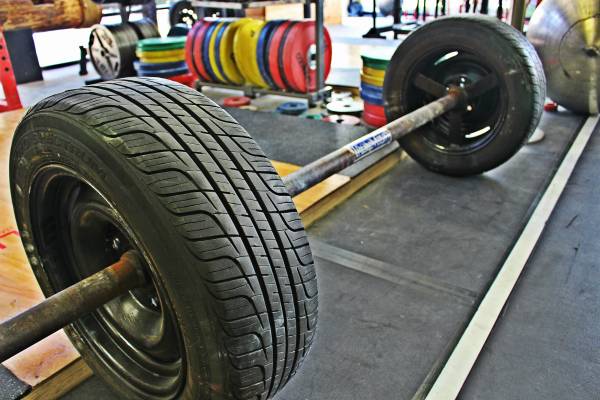
Axle bar deadlifts will test your grip strength as much as your pulling power. Ditch the straps in training to enhance your grip.
The Press
Being a good presser is necessary in the sport of strongman. Strict press, push press, and single arm press are all important exercises to improve your overhead strength.
Pressing should be done on a weekly basis with additional shoulder work to increase shoulder stability to support heavy loads.
Pressing variations found in competition:
- Log Clean and Press: It is difficult to train for a log press without a log. Barbell clean and jerks are a great assistance tool, as well as pressing overhead with a Swiss bar, but moving a log is vastly different than a barbell. If you can, go out of your way to find a log to train with.
- Axle Bar Clean and Press: Similar to the axle deadlift, this movement can be simulated by putting fat gripz on a barbell. Remember, the axle bar does not spin like an Olympic weightlifting bar. In addition to the conventional clean, another method that can be used is the continental clean.
- Circus DB: The Circus dumbbell is a single-arm press where the dumbbell can be brought to the shoulder with two hands and then pressed or jerked with one arm. Training for this event can be done by performing single arm dumbbell presses, and by adding fat gripz onto the dumbbells for an extra challenge.
- Viking Press: The Viking press uses a bar with two handles stemming off of a fixed point. The press extends up and forward, towards the fixture, instead of straight up like an overhead press. Kalle Beck of Starting Strongman has a great Viking press simulation.
Loading Events
Loading events in strongman competition present endless possibilities. The best way to prepare for a loading event is to pick up a heavy object and place it on a platform or over a bar.
You will expend a lot of energy on these events, so I recommend making one day of your training week an “event day,” and practice multiple event movements, including loading. This will help you gauge the maximum weight you can load if you are already fatigued from deadlifting or squatting.
Loading variations found in competition:
- Atlas Stones: These events typically involve moving stones over bars or on to platforms of varying heights. The best way to train for atlas stones is to use them. I highly recommend finding a gym that has some, and practicing with them. Many CrossFit gyms are investing in stones, so they are fairly easy to find.
- Sandbag: Sandbags are a versatile implement that can be carried, loaded onto a platform, or loaded onto something that can then be dragged. They are probably the most affordable and easiest of all of the equipment to make, so I suggest buying your own and using it at home.
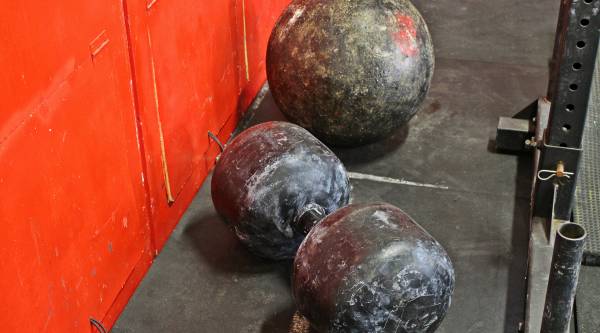
Many CrossFit gyms have an array of Atlas stones on hand already, so you may not need your own.
Carrying Events
Carrying, holding, and moving events may be the simplest to train for. The best way to prepare for moving events is to pick up a heavy object, and move with it.
If you know what implement will be used in competition, find an object similar in size and weight, and practice carrying it. These events can vary, but typically they are measured by time in a set distance, or max distance in a set time.
This is another item to add to your event training day, separate from conventional lifting days.
Carrying events found in competition:
- Sandbag Carry: The sandbag is typically bear-hugged or carried in front of the body, no shouldering allowed. These events can be for time or distance.
- Keg Carry: Similar to the sandbag, the keg carry event is a front-hold carry. Kegs are fairly easy to find, so go out and buy one, fill it up with water or sand, and carry it for 100ft runs.
- Conan’s Wheel/Zercher Carry: These are front-loaded carries with the bar resting in the crook of your elbow. Train with a heavy barbell and do max holds. Practice breathing with the weight pushing down on you. This event never feels good, so it’s best to build up a tolerance with being uncomfortable.
- Yoke Carry: Unlike the carries mentioned above, the yoke walk is a posterior load, with the weight resting on your back and shoulders. To simulate the yoke carry, load a heavy barbell and place it on your back. Heavy holds are great for core stability, but walking with the weight on your back is ideal for competition training.
- Farmers/Frame Carry or Hold: The farmer’s handles and frame are gripped from the side of the body and deadlifted to a standing position. At this point, they will either be carried or held in place. The best way to prepare for these events is with a trap bar or heavy kettlebells. In competition, the weight will be very heavy, probably close to a max deadlift. These events are an excellent test of both physical and mental strength.
- Tire flips: This is the event that is difficult to simulate in the gym. If you know that this event is going to be in your competition, find a tire and start flipping.
Pulling Events
If you ask the average person what they know about strongman, they will probably say “aren’t those the guys who pull trucks?” Pulling events are always a crowd favorite, so you better step up your game.
The key in this event is to stay low and keep moving. Once the wheels start turning, momentum will be in your favor, but it is hard to start again once you stop.
Truck pull events can either be a harnessed pull with the truck behind you, or a seated pull facing the truck. They are typically a set distance for time.
The best way to train this event is to put a car or truck in neutral, harness yourself to it, and pull. If that isn’t an option, sleds are a great alternative. You can find inexpensive options online if your gym does not have a sled.
Train What You Can, Expect the Unexpected
This is not an all-inclusive list of events, but part of the fun in strongman is expecting the unexpected. Your first priority in strongman is being strong.
Without strength, you will not get very far. Focus your training around the deadlift, overhead press, and squat. Use weighted holds and carries for core strength, and your assistance work should include cleans, rows, curls, abs, and grip work.
For specific training plans, check out these programs:
- A list of training resources and a free 12-week program from Starting Strongman
- A 12-week training cycle by Breaking Muscle
If you absolutely cannot find a gym with strongman equipment to train once a week, invest in a few implements and train at home. A sandbag, keg, sled and a pair of fat gripz should be enough to get you started. Now go forth and do strong things!
More Strongman Strategies and Secrets:
- Why You Should Listen to Strongman Odd Haugen
- Must-Have Equipment for Strongman Training
- 4 Needless Mistakes You’re Making in Strongman Training
- New on Breaking Muscle Today
Photos courtesy of The Training Hall.

